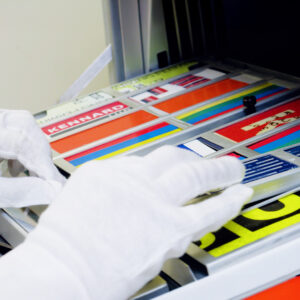
You might be familiar with the digital printing technique and have probably seen digital printers in most homes and offices. This technique has become the popular printing option that is readily available but it might not always be the ideal option for your project or needs. Understanding a printing technique, how it works, the printing speed and the type of result it produces can help you understand how your image or design will look like and if it this printing technique is for you.
In this article we will discuss the digital printing technique, how it works, its advantages and disadvantages along with the different types, with the aim to help people decide if this method is ideal for their needs and how to use this technique to get the best results.
Digital printing is a popular printing technique that uses ink or laser to print a digital-based image directly from a computer onto a surface. Most printers found in home and office are digital printers, but these are commercial digital printers that are made more compact and easy to use for commercial reasons. Digital printers used by most printing shops are much larger and powerful than commercial printers.
The first digital printing machine, named “Indigo”, appeared on the market in 1993 made by a company with the same name. HP invested $100 million into Indigo in the year 2000 becoming the first big investors in digital printing, later in 2001 they would go to acquire the company for $629 million. Digital printing since then has steadily increased in popularity over the years making up an estimated 18% of all printing done globally and finding its way into offices and even people’s homes.
True to its name, digital printing involves taking a digital image from a computer and printing that image onto a print media using either ink, toner or a laser mechanism depending on the type of printer used.
First a digital image is chosen to be printed, this image can be a picture downloaded from the internet or even a hand drawn picture scanned and uploaded onto the computer.
After the image is selected the specifications and resolution is checked before hitting the “print” button. The digital printer will then start printing the image onto the surface of the print media using either ink or laser mechanism.
Notably there are two different kinds of digital printing machines, the inkjet printer, and the laser printer. The feature that separates these two printing machines is the method through which the pigment or colour is applied onto the surface.
This printer utilises ink which is applied onto the surface by a print head consisting of multiple tiny holes. The print head moves horizontally across the surface of the print media and the tiny holes activate to drop the ink onto the surface. The drops of ink are microscopic and forms a solid-coloured image.
The inkjet printer is slower than the laser printer and the ink cartridge does not last as long, but the colour produced through this method is more vivid.
Laser printers are vastly different than inkjet printers and more complex. Laser printers use toners, which are electrically charged powdered ink, and a drum to apply the toner onto the paper or surface.
Toner cartridge: Consumable items which contain carbon/iron oxide powder dye which are positively charged and applied onto the paper to create the image.
The Drum: A metal cylinder that receives electrical charges from the laser. It is used to apply the pigment onto the surface.
Laser: It transmits light onto the drum unit, using a series of mirrors, and imprints the shape of the image onto the drum.
Transfer Unit/Roller: Moves the paper through the printer and onto the drum for the toner to be applied.
Fuser Unit/Roller: Helps melt the toner onto the surface so the pigment does not melt and is set properly.
First the drum in the printer rotates next to a “primary charge roller” which applies a negative charge to the drums, then a laser is used to form the image onto the drum, this image is positively charged.
The toner cartridge is located next to the drums and contains negatively charged particles which get attracted to the positively charged areas created on the drum.
A transfer belt or developer roller gives the paper a positive charge, the drum applies the toner onto the print surface, which is attracted to the positively charged areas, hence forming the image. The toner is then melted and set using a fuser which is a heated roller in the printer.
Laser printers are much faster than inkjet printers and the toner cartridge last longer than ink cartridges, although the colour produced is not as vivid as the colour produced by inkjet printers.
Digital printing comes with its own advantages and disadvantages over the other printing techniques.
Advantages

Disadvantages
Digital printing is ideal for producing complex and detailed images in small batches. Its relatively cheap, easy to set up and can be used to print small images quickly, although it can print medium size images if needed. Photographers and artists love this form of printing as it allows them to print an image that is identical to its digital version, with the details clear and the colour in the image identical to its digital version.
If you’d like to place an order or request a quote, then you can contact us at 1300 627 548 or sales@signprintaustralia.com.au and our experienced staff will help you.
Monday 7:30am-400pm
Tuesday 7:30am-400pm
Wednesday 7:30am-400pm
Thursday 7:30am-400pm
Friday 7:30am-400pm
Saturday Closed
Sunday Closed